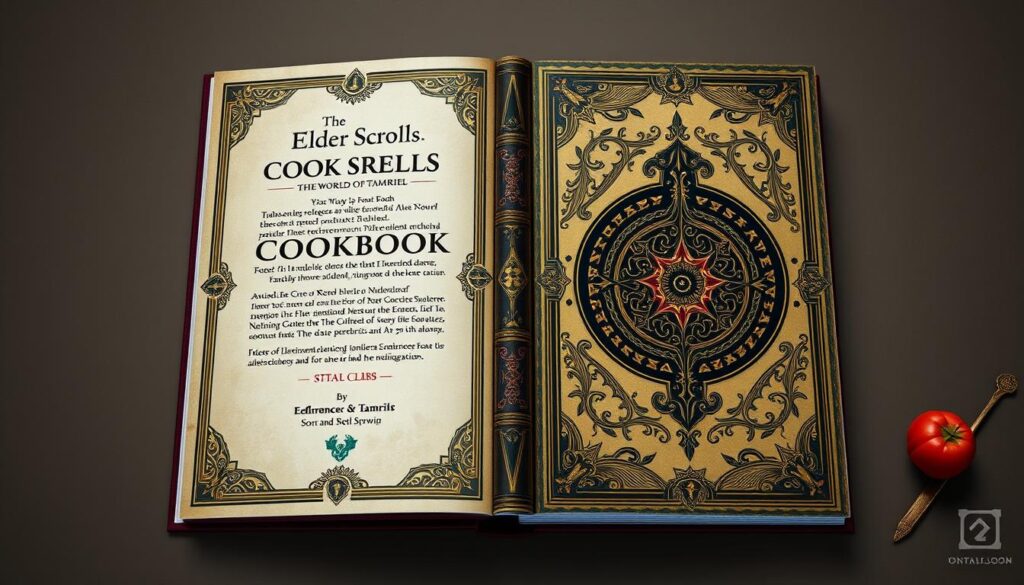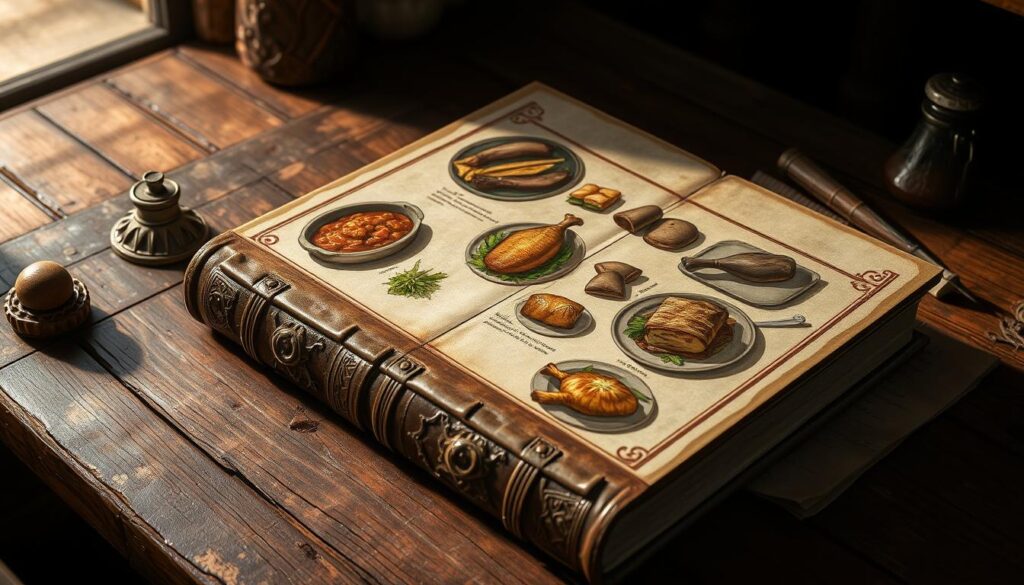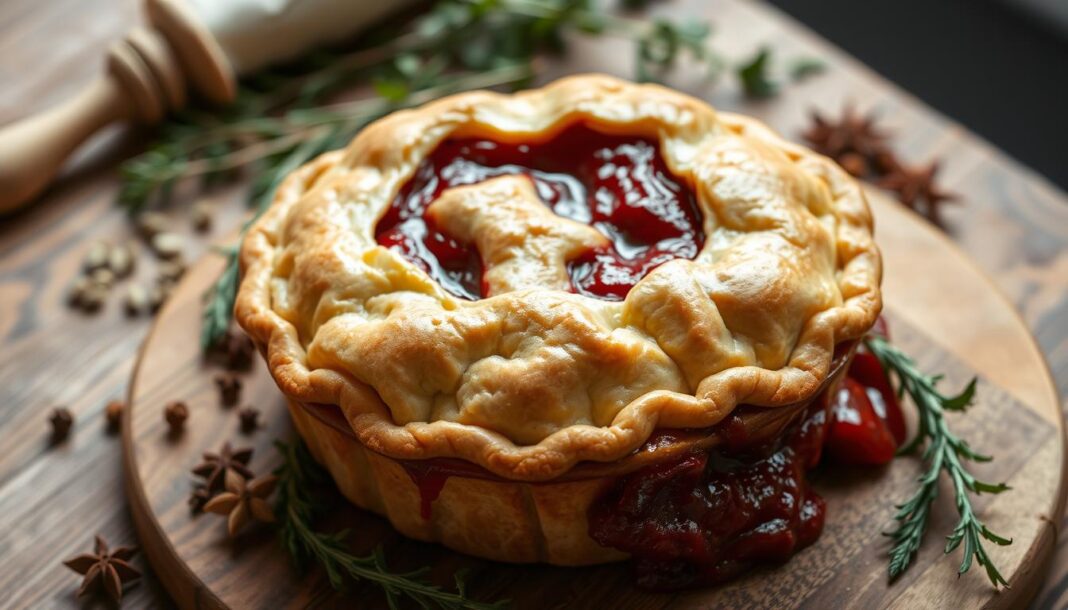As fans of the iconic Elder Scrolls game series and culinary enthusiasts, we’re excited to dive into The Elder Scrolls: The Official Cookbook Vol.2 (Tastes and Tales from Tamriel), authored by Victoria Rosenthal and Erin Kwong.
This Elder Scrolls Cookbook promises to bring the flavors and cultures of Tamriel to our kitchens. With its hardcover and jacket, 208 pages, and release date on September 17, 2024, we’re eager to assess its culinary and physical quality.
We’ll examine how well the recipes capture the essence of Tamriel’s diverse regions and cultures, and analyze their accessibility for home cooks of varying skill levels. As part of the Elder Scrolls universe, this cookbook is a unique blend of gaming inspiration and culinary expertise.
The Elder Scrolls Cookbook: A Culinary Journey Through Tamriel

The Elder Scrolls Cookbook is more than just a collection of recipes; it’s a culinary journey through the vast and diverse world of Tamriel. This comprehensive cookbook delves into the cuisine of the Elder Scrolls universe, offering fans a unique opportunity to explore the game’s lore through cooking.
Physical Quality and Presentation
The physical quality of the Elder Scrolls Cookbook is impressive, with a sturdy cover and high-quality paper that makes it a joy to handle. The presentation is equally impressive, with beautiful illustrations and photographs that showcase the dishes in an appealing way. The cookbook’s design effectively transports readers into the world of Tamriel, making it a must-have for fans of the game.
Organization and Structure
The cookbook is well-organized, with chapters that mirror the different regions of Tamriel. Each chapter is preceded by fictional narratives about a culinary explorer and in-universe author, adding a layer of depth to the cookbook. The recipes are structured in a clear and easy-to-follow manner, making it accessible to cooks of various skill levels. For more information on exploring fantasy food, visit our page on fantasy food.
Lore and Storytelling Elements
The Elder Scrolls Cookbook excels in its incorporation of lore and storytelling elements, weaving the narrative of the Elder Scrolls universe into the recipes. Every dish is accompanied by a block of “fluff” that adds to the world-building and entertainment value of the book. This narrative integration enhances the immersive experience, connecting readers more deeply with the game world. As a result, the cookbook offers a rich experience for both new and veteran players of the Elder Scrolls game.
Recipe Exploration: From Simple to Complex
As we delved into the Elder Scrolls cookbook, we discovered a variety of recipes that span the spectrum from simple to complex. The cookbook caters to different culinary skills, offering something for everyone.
Standout Recipes Worth Trying
Some recipes in the cookbook stand out for their unique flavors and presentation. For instance, dishes that incorporate exotic ingredients like pandan leaf extract or kabocha (Japanese pumpkin) offer a distinct taste of Tamriel’s culinary world. These recipes not only challenge the palate but also provide an opportunity to explore new flavors.
The cookbook includes a range of dishes, from hearty stews to intricate desserts, making it a valuable resource for cooks looking to experiment with new recipes.
Challenging Culinary Adventures
Certain recipes in the Elder Scrolls cookbook present a culinary challenge, particularly those requiring specialized ingredients such as Branzino (a whole fish) or several cups of duck fat for confit. While these ingredients may be hard to source, the cookbook often provides substitutions, making it more accessible to cooks without access to high-end markets.
The complexity of some recipes also stems from the techniques involved, such as preparing confit or cooking specific types of fish. However, these challenges are part of the fun, and the cookbook’s detailed instructions help guide cooks through the process.
Ingredient Accessibility Issues
One of the challenges faced by cooks using the Elder Scrolls cookbook is sourcing the exotic ingredients called for in various recipes. While the cookbook provides substitutions for some hard-to-find items, cooks outside major metropolitan areas may still face difficulties in obtaining certain ingredients.
To address this issue, cooks can explore online shopping options or visit specialty stores that carry international ingredients. Additionally, being flexible with ingredient substitutions can help make the recipes more accessible.
Gaming Authenticity: How Well It Captures the Elder Scrolls Universe
Delving into the Elder Scrolls Cookbook, we examine its authenticity in representing the game’s universe. The cookbook’s ability to capture the essence of the Elder Scrolls series is a crucial aspect of its appeal to fans.
Regional Cuisine Representation
The cookbook attempts to represent various regional cuisines from the Elder Scrolls universe, such as those from the provinces of Cyrodiil and Morrowind. Regional specialties are a highlight, with dishes that reflect the diverse cultural influences within the game. For instance, the inclusion of recipes inspired by the Dunmer (Dark Elf) cuisine showcases the rich culinary heritage of Morrowind.

Iconic Game Foods Brought to Life
Iconic foods from the game, such as Sweetrolls and Nirnroot Salad, are given new life in the cookbook. While some recipes, like the Sweetrolls, deviate from their in-game counterparts, others like the Nirnroot Salad (reinterpreted as a beet salad with homemade vinaigrette) stay true to the spirit of the game. The balance between creativity and authenticity is key.
| Iconic Food | Cookbook Interpretation | Authenticity Level |
|---|---|---|
| Sweetrolls | Modified recipe | Low |
| Nirnroot Salad | Beet salad with vinaigrette | High |
Missed Opportunities and Creative Liberties
The cookbook takes some creative liberties, such as substituting “lizardfruit” for plums and creating a “Singing Tuber Salad” instead of directly using Nirnroot. While these choices may disappoint some fans, they also offer a fresh perspective on the game’s culinary elements. The key is whether these liberties enhance or detract from the overall experience.
Ultimately, the Elder Scrolls Cookbook walks a fine line between faithfulness to the game and culinary creativity. Its success in capturing the essence of the Elder Scrolls universe will depend on the individual fan’s expectations and appreciation for the game’s culinary aspects.
Is This Cookbook Worth Adding to Your Collection?
As we conclude our exploration of the Elder Scrolls Cookbook, it’s clear that this culinary journey through Tamriel offers a unique blend of flavors and lore. With a rating of 4 out of 5, Volume 2 presents a mixed bag of experiences for fans and cooks alike.
The cookbook’s great presentation and overall value are significant positives, making it a worthwhile addition to any Elder Scrolls fan’s collection. However, the complexity of some recipes and the lack of specificity in others may deter less experienced cooks.
We believe this cookbook is aimed at a more culinarily-experienced audience than typical pop-culture cookbooks. Its appeal will vary across different segments: casual fans may appreciate the lore and presentation, while serious cooks will value the unique recipes. Collectors will enjoy it as a piece of gaming memorabilia.
When considering the price-to-value ratio, the cookbook’s physical quality, recipe count, and unique content justify its retail price. While it may not become a frequently used kitchen resource for everyone, it will surely be a cherished novelty for fans. We recommend it to those who enjoyed Volume 1 and are looking to expand their culinary adventures in the Elder Scrolls universe.
In conclusion, the Elder Scrolls Cookbook: Volume 2 is a meaningful expansion of the franchise, offering a blend of gaming culture and culinary exploration that is sure to delight fans and food enthusiasts alike.


